Industrial and residential premises with a high risk of potential fire hazard require special cables for laying power lines. Ordinary insulated wires are completely unsuitable, as they do not comply with safety standards. One of the best solutions is to highlight the PPGng(A)-HF cable. But, due to what it provides such a high level of security?
Technical characteristics of industrial PPG cable
A copper, conductive core consists of a single wire. This approach made it possible to minimize current losses during transmission over short and medium distances. At the same time, the cable has lost some of its flexibility, and is suitable only for stationary laying of the circuit. The main technical characteristics of the products are the following factors:
- Insulation and sheath made of a special polymer composition.
- The design does not contain a cord that protects the cable from breaking.
- Not prone to spreading flames in the event of an indoor fire.
- Sufficiently reliable for long-term operation.
- Completely safe for people, does not emit toxic substances into the atmosphere.
Important: cable products are recommended for connecting a wide variety of technological equipment. Including for the domestic sector, if it is necessary to allocate a separate circuit for a highly loaded electrical consumer. Boiler, electric stove and other household appliances with high energy consumption.
VVG alternative cable
The industry produces a fairly large variety of electrical cables. For the domestic sector, with moderate network loads, a simpler cable that can serve as a current conductor for decades will be quite enough:
- individual insulation of copper conductors with polyvinyl chloride;
- general sheath made of a simple polymer;
- no additional protection for tearing and stretching;
- minimum smoke and toxicity in case of combustion.
Modern cable VVGng(A)-LSLTX has a more attractive cost for consumers. It is ideal for laying power lines in the walls of a building to household sockets and conventional electrical appliances. The cable does not require additional protection measures other than the standard requirement. DC voltage up to 1 kW and potential surges up to 1.5 will be quite a standard norm, which will not lead to overheating and melting of the insulation.





